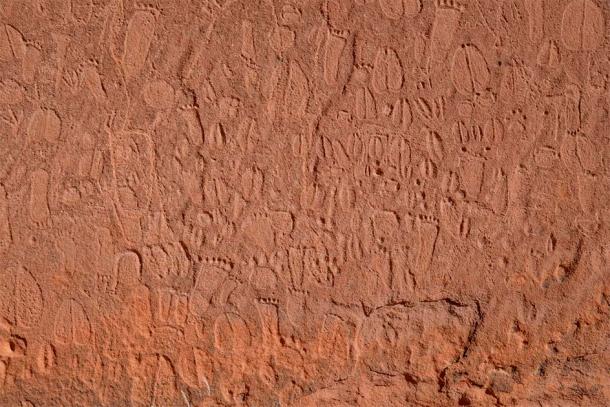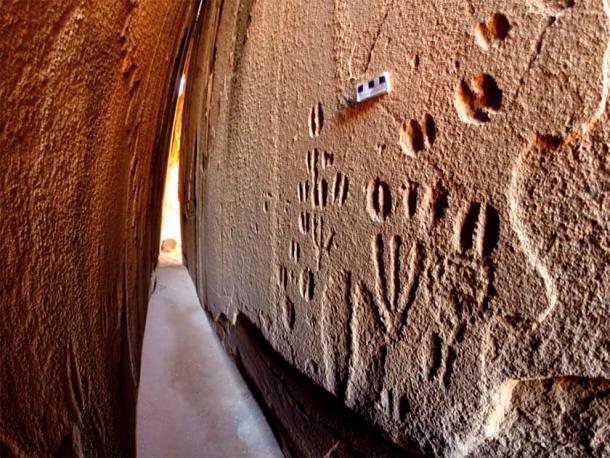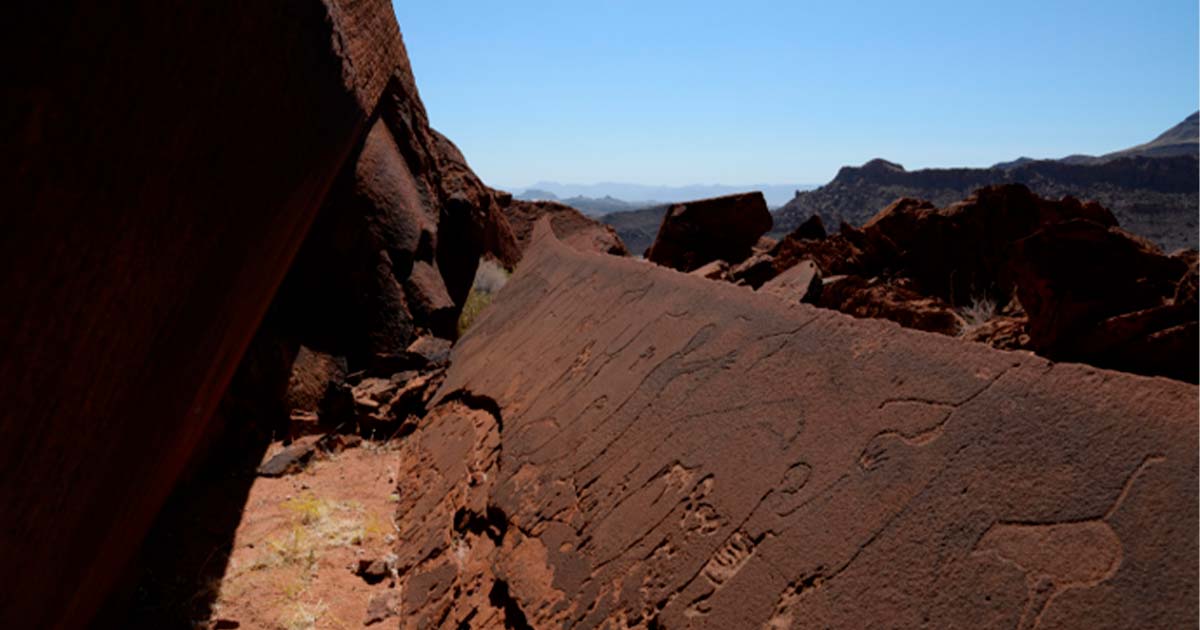Encoded Information Found in Stone Age Animal Track Engravings in Namibia
A trio of German archaeologists commissioned three indigenous trackers from southern Africa to analyze hundreds of animal track engravings made by Late Stone Age (25,000 to 3,000 BC) hunter-gatherers in the Doro Nawas mountains of west-central Namibia. Amazingly, these experts were able to extract an extraordinary amount of data from these images, including the species, sex, age and exact leg of the animals whose footprints were recreated in this unique collection of ancient African rock art.
Notably, studies of animal tracks found in other parts of Namibia have not revealed the presence of markers that could disclose such details.
“The analyses reveal patterns that evidently arise from culturally determined preferences,” the archaeologists wrote in an article about their research appearing in PLOS One. “The study represents further confirmation that indigenous knowledge, with its profound insights into a range of particular fields, has the capacity to considerably advance archaeological research.
The Flourishing of Footprint Artistry in Late Stone Age Namibia
The hunter-gatherer peoples of Late Stone Age Namibia were rock art aficionados. Their skilled artists carved thousands of images into rock faces across the region. While the usual depictions of animals and geometric figures were included, the ancient people of Namibia were especially dedicated and proficient when carving lifelike images of animal tracks from a wide range of species.
- The Braided Rapunzels of Namibia: Every Stage of Life is Reflected in Their Hair
- Namibia’s Apollo 11 Cave – How We Gained Insight Into The Minds Of Our Ancestors

Detail of Stone Age depictions of human footprints and animal tracks in Doro! nawas mountains, Namibia. (Andreas Pastoors/PLoS ONE)
To discover what kind of data these tracks might reveal, the three German archaeologists—Andreas Pastoors and Thorsten Uthmeier from Friedrich-Alexander University of Erlangen-Nürnberg and Tilman Lenssen-Erz from the University of Cologne—recruited three indigenous animal tracking experts affiliated with the Nyae Nyae Conservancy in Tsumkwe, Namibia to take a closer look at 513 samples, to see how they might be interpreted. This particular collection of animal tracks had been discovered recently engraved in rock faces in Namibia’s Dora Nawas Mountains, and the images were notable for their vividness and the precision with which they were carved.
“Seen from the perspective of western art history, researchers are unable to recognize anything in these images, as they are lacking the relevant expertise,” Pastoors explained in a Friedrich-Alexander University press release discussing his team’s study. “For this reason, the tracks have not yet been assessed as a legible source of information, which has in turn led to misleading hierarchies being created with regard to the value of the various images.”
The three Namibian indigenous trackers, who’ve been identified as Tsamgao Cique, /Ui Kxunta and Thui Thao, were known to have extensive knowledge about the animals native to their home region. But their knowledge proved to be even more vast than the German archaeologists had anticipated. They recognized the footprints of an enormous number of animal species, including those that are most common now and that were most common in the past.
- The Maasai Legend Behind Ancient Hominin Footprints in Tanzania
- Namib Desert Engravings Provide Fascinating Insight into Ancient Initiation for Girls

Animal tracks carved in a hidden panel of the RAS 8 rock art site. (T. Lenssen-Erz/PLoS ONE)
Incredibly, the indigenous trackers were able to identify the animal represented in over 90 percent of the engraved footprints they were shown. Because the images were so clear and detailed, they were able to detect markers in them that revealed how old the animal might have been, whether it was male or female, and from which leg (front or back, right or left) the track would have come.
Overall, the tracking experts identified about 40 different species of animals, with the tracks of giraffes, white and black rhinos, kudus, guinea fowls and springboks being most frequently depicted. Also fairly common were the engraved footprints of baboons, buffalos, African wildcats and blue wildebeest. On the other end of the spectrum, only a single cheetah footprint has so far been found.
Interestingly, the sheer number of different species represented in the Doro Nawas animal track collection exceeded the number of species shown in more typical engravings of animal heads or full bodies. The experts identified the tracks of 20 different species that were not shown in any other form, including different varieties of monkeys, birds, buffalo and antelopes.
Another eye-opening discovery is that some of the animals represented did not live in the Doro Nawas region (they couldn’t have survived the desert-like conditions), but in other parts of Namibia, or even beyond. Which of course raises the question, how did the artists know about the existence of these animals? And why would they bother to make engravings of them, if they weren’t species that local hunter-gatherers would have relied on as a food source?
“We cannot answer these questions with the state of research as it stands at present,” Pastoors acknowledged. “However, it is plausible that the artists knew other regions with damper environmental conditions, as the Doro Nawas mountains were similarly dry as they are today.”
While the majority of the 513 tracks that Cique, Kxunta and Thao were shown came from animals, about 20 percent of them were actually carvings of human footprints. In these instances, the trackers were still able to discern facts about the person’s age and sex.
The ancient artworks, which would have been made sometime between 5,000 and 50,000 years ago, feature 398 tracks of mature animals and 98 tracks from younger ones. Male tracks were more frequently depicted, outnumbering female prints by 227 to 180. The remaining carvings revealed 106 human footprints, of which 74 were male and 32 female.
“It appears to be the case that prehistoric engravers did not produce generic human footprints without markers of sex or age,” the study authors wrote in their PLOS One article. “Similarly, the engravings of animal tracks do not include generic forms; instead, each is specific.”
For whatever reason, the vast majority of the human engravings—91 in all—represented juvenile subjects. There is no way to know for sure why this was the case, but perhaps ancient Namibian artists enjoyed making engraved images of their children’s feet for posterity, just as modern-day parents often save handprint or footprint art produced by their kids as keepsakes.
What Does it All Mean? No One Knows for Sure
As for the purpose of all these tracks, the German archaeologists believe the engravings are “endowed with complex meanings.” But beyond this general understanding, they aren’t sure what the tracks are really meant to depict or communicate.
“The difficulty we note here is one that arises in the interpretation of all prehistoric art,” Pastoors explained. “Consulting present-day indigenous experts can partly mitigate this issue, enabling Western researchers access to greater depth of insight through the outstanding precision and plausibility of indigenous knowledge; yet often, as in this case, the precise meaning and context of the art will remain elusive.”
What is known is that the data encoded in the Late Stone Age animal tracks would have been meaningful to the hunter-gatherer societies that created this form of art, writing or record keeping. With the assistance of their Namibian compatriots, the German archaeologists involved in this latest study will continue to analyze the tracks, hoping to discover subtle patterns in their design, alignments and groupings that might reveal something about the true purpose of the Late Stone Age animal track “language.”
Top image: Stone Age animal and human depictions in Doro! nawas mountains, Namibia. Source: Andreas Pastoors/PLoS ONE
By Nathan Falde

















